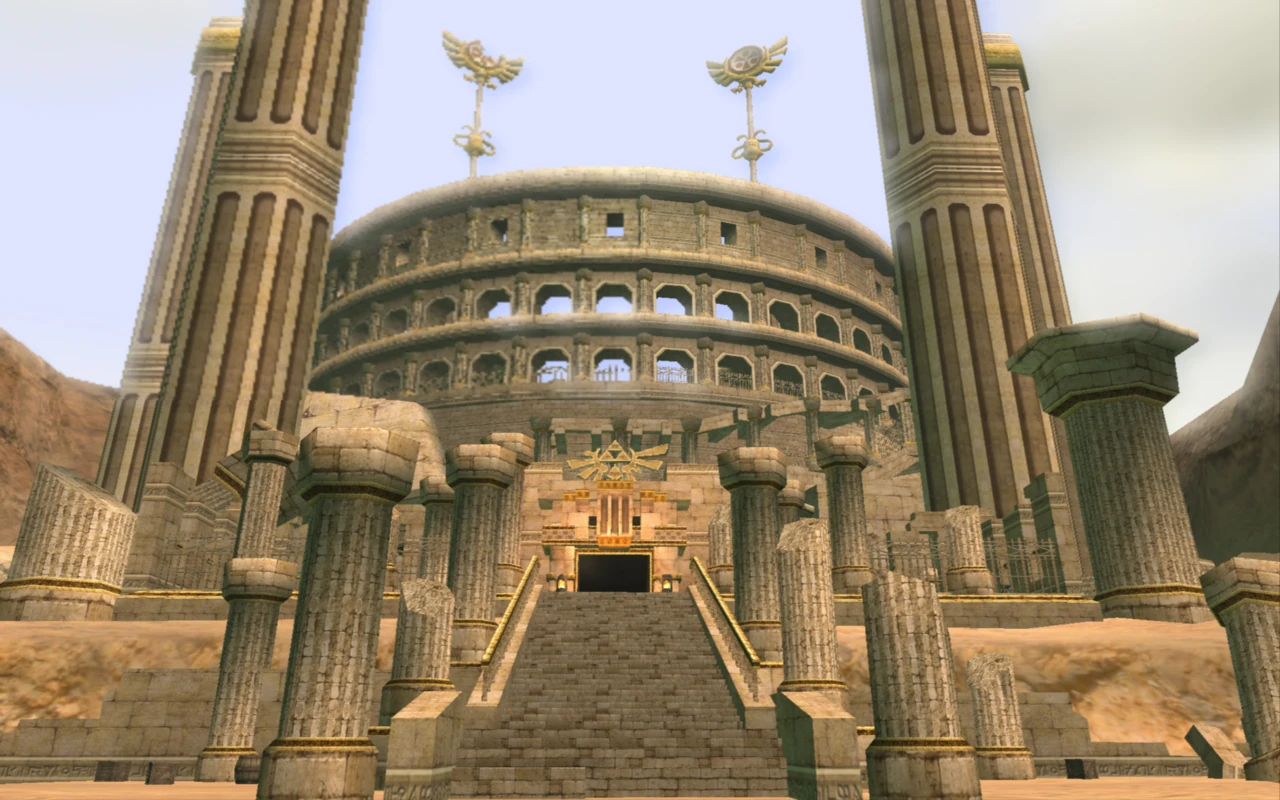Arbiter’s Grounds is a Sinister Reflection of Hyrule’s Own Insidious Actions
Posted on January 27 2023 by Judy Calder

The Legend of Zelda is a series filled with wonder, beauty, and lore. These are some of the key elements that make Zelda games so special, and they’re woven through the fabric of every character, enemy, musical score, and dungeon the player comes across. The result of such weaving is a stunning architecture of distinctive environments and unforgettable encounters. And there are few more memorable and more haunting architectures than that of the Arbiter’s Grounds in Twilight Princess.
Hyrulean History
Protruding from the wastes of the desert, six pillars stretch towards the heavens, crowning a monument that testifies to Hyrule’s ancient and lawful civilization. The crest of the Royal Family of Hyrule and the mark of six Sages on top of those pillars can be seen from afar. They have survived the ravages of time, even if they are presumably forgotten to modern society. Auru, a member of The Resistance, teaches Link about the far-off structure:
“The Gerudo Desert once held a prison built to hold the worst criminals this land has ever known… The criminals who were sentenced to death were sent directly to the underworld by a cursed mirror that was kept in the prison… Now that prison is condemned, and even the road leading to the desert is impassable.“
Auru’s words offer a striking insight into the Hylian Royal Family’s dominion across the land, and Arbiter’s Grounds stands as a stark reminder of its supremacy. Here is the very place where judgement was passed, evil was chained, and condemnation meant death. However, it seems as though this aged monument predates even Hylian construction — or appropriation.
When we venture closer and further inside, we notice Gerudo symbols and glyphs carved throughout the dungeon. And located in the Gerudo Desert, it only makes sense that the Arbiter’s Grounds once belonged to Gerudo clans. An even stronger link to the Gerudo is the fact that there are derivations of the Sand Goddess inside this cavernous building, which we’ve seen before in Ocarina of Time’s Spirit Temple. A natural assumption would be that Arbiter’s Grounds was once home to a Gerudo place of worship, or some other structure of cultural significance. What dark or hidden narrative lies behind the judicial façade of this place? How did the Hylians come to repurpose something that clearly held some level of importance to other peoples? We must remember that history is written by the victor, and there could be much we don’t know. Verily, Arbiter’s Grounds must be a treasure trove of Zelda lore which we haven’t discovered — yet.

An Unsettling Setting
Arbiter’s Grounds is the fourth dungeon in Twilight Princess, and the player will immediately notice a shift in the tone of the game. Everybody knows that this title is one of the “grittier” Zelda installments, but it doesn’t truly feel dark until we enter the dungeon itself. The theme music, with its low, rhythmic drumming and the eerie rising and fading of strings, gives us an idea of what to expect inside this prison, because it actually sounds like you should be afraid. Somehow, this piece of music encapsulates a feeling of dread on every note, inciting terror at what could be around every corner.
Looking around in the dark, it’s impossible to not notice how tomb-like the inside of this structure is, especially compared to Egyptian pyramids. This realisation has the potential to unnerve you at the very least. The ancient, dusty stonework with royal crests, the pits of quicksand, and the eerily glowing torches in one recognizable chamber only add to the atmosphere. You can imagine the sour stench of decay in the air because a place like this — so clearly abandoned — just has to house something undead. The cutscene as Link ventures forth solidifies the build-up of fear that the player must be feeling at this time. As ghostly lanterns snatch the torch’s flames and the portcullis behind them slams shut, a chill is likely to run right through you… Fight or flight; prepare to battle or save and quit. The situation and all of these elements create some potent nightmare fuel.
The dungeon carries on with this unsettling theme throughout, and I’ll admit that I’ve personally spent a lot of time peeking around the corners with my heart in my mouth. Even those short, quiet moments, before they are interrupted with the booming thud of a drum or far-off screech, leave space in my soul for apprehension. For what comes after silence in gaming but shock and surprise? Arbiter’s Grounds is truly artful in its thematic efforts to inspire fearful emotion in the player. And if its theme begged any question, it would be: What happened in this court of judgement, and why does the feeling of dread practically emanate from its walls?

Monsters and Mechanics
I mentioned previously that Arbiter’s Grounds is tomb-like. This was no coincidence considering the dungeon’s uncanny Egyptian-esque design, accompanied by its historical purpose, and the monsters that inhabit it. Some of the main enemies include the Stalchild, Gibdo, Stalfos, and Staltroop. The place is teeming with the undead! Perhaps the wretched bodies of those imprisoned here were cursed to walk its halls forever, refusing to forget how Hyrule banished their comrads to hell. We know the place is haunted at the very least, with Big Poes taking up a sizeable portion of the gameplay. These entities aren’t to be trifled with, unless you’ve got some wolfy senses to give you the upper hand, that is. Using his Senses, Link can see the Big Poes in all their ghostly glory, and he can combat them. It’s a strange yet satisfying thing, to move through this structure as Link in both of his forms, collecting the souls that will unlock the secrets of such a mysterious dungeon. It lends a secret strength that fuels your courage to push deeper into the unknown darkness ahead.
One extremely interesting secret that lies within Arbiter’s Grounds is Death Sword, the dungeon’s mini-boss. Link encounters this enemy when he finds a large sword embedded in the ground, bound by ropes with mystic talismans attached. This is clearly some sort of curious protective magic, and Link unwittingly breaks its power by cutting one of the ropes, freeing the evil spirit within. Did the Hylians trap this dark entity, or was it bound by those who predecessed them? Where did it come from and why? Who trifled with something beyond their measure? There are many questions that lead to more questions in this dungeon.
The battle with Death Sword ensues, and, once again, the Wolf mechanic and use of Senses comes into play. It’s true to say that Twilight Princess forces the player to use its gimmick, but with battles like this one, you can’t and shouldn’t complain. Tackling Death Sword in Wolf form and hearing his demonic scream when you successfully harm it definitely leaves an impression. The battle feels similar to that of a Big Poe, but with higher stakes and more options, because this enemy will eventually become vulnerable to Link’s weapons. Once Death Sword is bested and panic subsides, the player is rewarded with the Spinner, which is arguably the most singular item in the Zelda series.

The Spinner is clearly an ancient item and is obviously built for navigating the inner parts of Arbiter’s Grounds. Obviously the inner sanctum of this place was limited to certain people who had the skill to operate this type of machinery. Perhaps this area held secrets that only more important people could learn about. Or maybe whatever went on in this part of Arbiter’s Grounds needed to be concealed from prying eyes.
Theories aside, the Spinner allows Link to drift across quicksand without sinking, and features a spin attack that comes in handy for nearby enemies. Suddenly, we have a welcome distraction from unease with this wonderful new item! We now have the opportunity to enjoy what is likely the best platforming in any Zelda game, and making your way through this dungeon becomes so much more interesting. In fact, Arbiter’s Grounds turns into a veritable rollercoaster with the addition of the Spinner! Link is hitting new speeds, reaching new heights, and bouncing off walls on this thing. And its applicability in the boss battle is the cherry on top of the entire dungeon.
The final boss for Arbiter’s Grounds is Stallord. The mind spins as you wonder just what this beast is and how it ended up in the depths of this dungeon, but you don’t have time to dwell, because battle calls. This giant skeleton comes to life in a pit of sand and protects its vulnerable spine with Staltroops. Link’s only option of attack is to hop on the Spinner and circle the pit, and to find a suitable opening between the Staltroops in which to grind on Stallord’s backbone. Oh, and did I mention the Blade Traps that circle the pit alongside Link? The entire situation is a recipe for hellishly hyper, fast-paced fun. And somehow, this overrides any fear for those skeleton soldiers (strikingly similar to Hyrulean guards, which is noteable) that pop out from the sand.
Then, just when you think you’ve beaten the baddie, Arbiter’s Grounds has another surprise in store, and the Spinner is the only way to reach it. Up, up, up you go, and the dungeon’s linearity means there is only one way to proceed. Shock and horror as Stallord’s giant skeletal head rises once more from the dead and knocks Link down! The arena makes clear that the Spinner is once more the key to Stallord’s defeat, and so proceeds the most unique and entertaining battle across any Zelda game. You’re gaining speed, you’re dodging Blade Traps, bouncing from wall to wall, and knocking Stallord (as intimidating as he is) on his… skull. It’s definitely a wild ride! When you’ve dealt the required damage and all is said and done, there is no denying that the battle arena and the dungeon’s item far surpassed Stallord as the star of the show — and that’s saying something considering this guy is a cracking boss even without the mystery of how he came to be in the first place.

Now, we’ve reached the most fascinating and terrible part of this entire dungeon. Using the Spinner atop another statue of the Goddess of Sands, Link unveils the fragmented Mirror of Twilight. And so triggers a simple and entirely effective cutscene.
Five Sages appear, giving a first-hand account of the evil events that took place in Arbiter’s Ground so many years before. We witness the defeated Ganondorf, bound in chains and brought to justice. His end should have been swift but the gods intervened, and blessed with their sacred power, he laughed in the face of death, turning one of his gaolers to dust. What else could now be done but banish the King of Evil to the underworld? But as we know, Ganondorf instead found himself in another realm, with other innocent people. In their fear, the Sages had inflicted his wicked presence upon another world, condemning it, as they must have done each time they sent a prisoner to their untimely demise.
How unsettling it is to know that Arbiter’s Grounds, damned by the spirits and memories of the past, may be a sinister reflection of Hyrule’s own insidious actions.

Judy Ann Calder is the Managing Editor at Zelda Dungeon. She joined the ranks back in 2018, bringing some good old British charm to the table.
Contact: judy.calder@zeldadungeon.net



